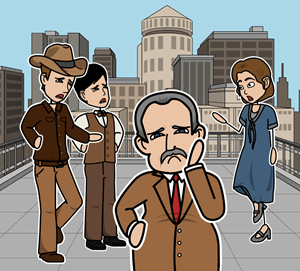Death of a Salesman - Five Act Structure

You can find this storyboard in the following articles and resources:

Five Act Structure: The Dramatic Structure
Lesson Plans by Rebecca Ray
Aristotle was one of the first to write about drama and describe its three segments: beginning, middle, and end. Many centuries later, a German playwright, Gustav Freytag, developed the five-act structure commonly used today to analyze classical and Shakespearean dramas. The pattern of this five-act structure can be seen in the familiar plot diagram.

Death of a Salesman by Arthur Miller
Lesson Plans by Rebecca Ray
Death of a Salesman is a play written and set during 1949. Arthur Miller used his play to represent a social drama and tragedy embodying the unattainable and elusive American Dream. His protagonist, Willy Loman, is a salesman whose disillusionment ends with his suicide.
'
Storyboard Description
Death of a Salesman summary in a five act structure
Storyboard Text
- ACT 1: THE EXPOSITION
- ACT 2 - CONFLICT / RISING ACTION
- ACT 3 - CLIMAX
- ACT 4 - FALLING ACTION
- ACT 5 - EPILOGUE
- Set in New York City in 1949, Willy, the protagonist, is a traveling salesman; his wife, Linda, is a stay at home mother; and his two sons, Happy and Biff, have grown up but have "yet to make something of themselves."
- During many flashbacks the audience is introduced to Willy's early life: His dreams, disillusionment, infidelity, and disappointments with being mediocre. With his sons visiting and urging him to speak to his boss about his job, Willy gets up the nerve to ask for a transfer. Instead of being transferred to the New York office, he is fired.
- In an attempt help their father, Happy and Biff take Willy out to dinner. While at dinner, Willy becomes upset and leaves.
- Willy's delusions get the best of him, and he kills himself in a car crash to provide his family with the $20,000 of insurance money.
- At Willy’s funeral, Happy vows to prove that his father's life was not in vain and continues in the sales business. Biff realizes that his father's life and focus were on the wrong dream, and he goes back to the ranch, determined to find happiness in his work. Linda ends the play saying, "we are free".
Over 30 Million Storyboards Created







